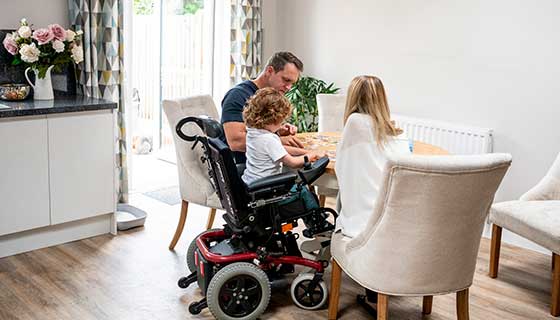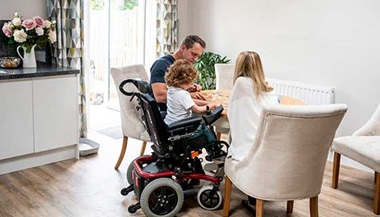Spinal Muscular Atrophy (SMA)
What You Need to Know
- Spinal muscular atrophy (SMA) is a disorder affecting the motor neurons—nerve cells that control voluntary muscle movement. These cells are located in the spinal cord.
- Because the muscles cannot respond to signals from the nerves, they atrophy — weaken and shrink — from inactivity.
- One in every 6,000 babies is born with SMA. It is one of the most prevalent genetic disorders affecting young children and a major cause of death in infancy.
- SMA can strike children at any age. SMA in infancy and early childhood is associated with worse outcomes, while patients who develop symptoms later in childhood or in adolescence usually have a more positive prognosis.
- SMA does not affect sensory nerves or intellect, but it has been observed that many patients with SMA are highly intelligent.
SMA Signs and Symptoms
Spinal muscle atrophy symptoms vary, and may be mild or disabling, but involve a weakness of the muscles that control movement. Involuntary muscles, such as those in the heart, blood vessels and digestive tract, are not affected.
SMA weakens the muscles closest to the center of the body, including the shoulders, hips, thighs and upper back. The affected child may develop a curve in the spine (scoliosis) due to loss of size and strength of the back muscles.
Progression of SMA can also affect breathing and swallowing, which can threaten the life of the patient.
SMA Causes and Risk Factors
Spinal muscle atrophy is a genetic disorder. Most forms of SMA are caused by mutations of the survival motor neuron 1 gene (SMN1) on the fifth chromosome, resulting in insufficient expression levels of the SMN protein.
SMN is essential to normal motor function because it enables muscles to receive signals from the nerves.
New Hope for Patients with SMA
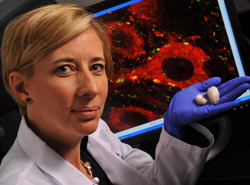
Patients with spinal muscular atrophy, or SMA, live in hope of simply standing or sitting upright. But neuromuscular disease specialist Charlotte Sumner says, “We are closer to a treatment for SMA than for perhaps any other inherited neuromuscular disorder."
Types of SMA
Spinal muscle atrophy is classified as type 1, 2, 3 or 4 depending on age of onset. Most cases are progressive — that is, symptoms worsen instead of improving – but in general the later the symptoms develop, the better the outcome for motor function.
SMA type 1 (infantile-onset SMA or Werdnig-Hoffman disease): This is the most severe kind of SMA and strikes infants within the first six months of life. Some children with SMA type 1 will die before their second birthday, but aggressive therapy is improving the outlook for these children.
SMA type 2 (intermediate SMA): When a child develops spinal muscular atrophy between six and 18 months, the condition is classified as type 2. The child may be able to sit up, but respiratory challenges can shorten their lives as the disease progresses.
SMA type 3 (juvenile SMA, Kugelberg Welander syndrome): Type 3 SMA emerges in children 18 months old or older and can become evident as late as in the teenage years. Muscle weakness is present, but most patients can walk and stand for limited periods, particularly early in the course of the illness.
SMA type 4 (adult SMA): In some people, SMA develops in adulthood. Type 4 SMA is rarely severe enough to have impact on the patient’s lifespan .
SMA not linked to chromosome 5: Some forms of SMA are not due to SMN1 gene mutations and SMN protein deficiency. These forms, including Kennedy’s disease, vary in severity, and some may involve muscles farther away from the center of the body than those associated with SMA types 1 through 4.
SMA Diagnosis
The symptoms of spinal muscle atrophy are similar to those of a number of other diseases affecting the muscles. To determine whether a patient’s muscle atrophy is due to SMA, the doctor may use the following tests:
- Genetic testing: a blood test that enables technologists to look for mutations of SMN gene on the fifth chromosome.
- Electromyography (EMG): a test that shows how muscles are receiving signals from the nerves.
- Muscle biopsy: a small piece of muscle removed for examination under the microscope.
Strength Under Pressure
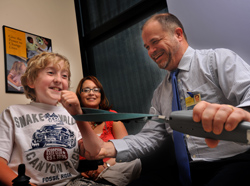
Tom Crawford has a long history of caring for children with SMA. He has treated more than 325 patients and participated in the discovery of the SMA gene, testing new treatments and developing care guidelines. Currently, he’s working to standardize an approach to test the impact of experimental therapies for SMA—and he’s making it entertaining.
Treating and Managing SMA
At present, there is no cure for SMA. Those affected by the disorder can work with their health care providers to manage SMA symptoms and prevent complications, which can contribute to quality of life.
Among the approaches that may be recommended:
- Medication: There are no current medications for treatment of spinal muscular atrophy. Several medications to improve muscle and nerve function are currently in clinical trials.
- Braces, support devices and wheelchairs: These can help patients maintain their independence as long as possible.
- Physical and occupational therapy and rehabilitation: In addition to therapy to keep joints flexible and to slow the progression of muscle wasting while improving flexibility and circulation,specific therapies for speech, chewing and swallowing may be appropriate. Proper feeding is essential to avoid aspiration (inhaling food or fluid into the lungs) and ensure good nutrition.
- Ventilation assistance: Patients with breathing difficulties may require non-invasive ventilation to prevent apnea while sleeping, while others may need assisted ventilation during the daytime as well.
Sofia's Story
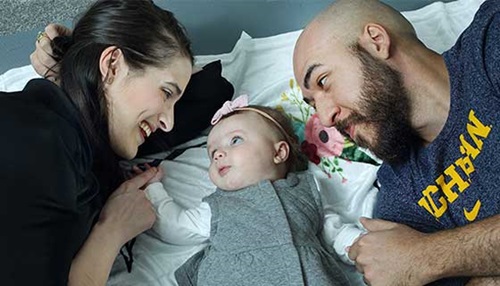
Sofia was born with SMA and treated with a revolutionary gene-targeting therapy. These therapies, while not a cure, have demonstrated new measurable motor milestones, such as head control, sitting, crawling and even standing.


